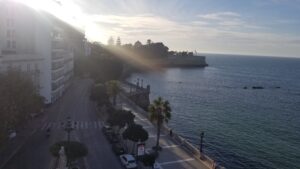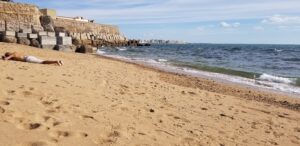I first got to know Claudia Franken through academic channels; she is a Europe-based scholar of Gertrude Stein and Arno Schmidt, a less-well-known prose writer who anticipates American postmoderns such as Thomas Pynchon. As his Wikipedia entry states, “Arno Schmidt (1914–79) was a German author and translator. He is little known outside of German-speaking areas, in part because his works present a formidable challenge to translators.” Claudia’s proposal for a session on “Avant-Gardes @ Zero Hour” took up Schmidt’s early “trilogy” of novellas focusing on cultural displacement after 1945, pursued by analogies to Egyptian and Phoenician antiquity—as if the two time frames were disturbingly (felicitously) co-present (see John E. Woods’s unequaled translation). The conference itself was canceled due to COVID but was revived as a webinar in March 2021, where Claudia presented her work on Schmidt—in a form, on first hearing, that was as allegorically complex as Schmidt’s work itself. I then engaged Claudia’s essay editorially, working toward publication in the Hunan, China-based Journal of Foreign Languages and Cultures, where it appears (here). All this is complicated, but is what it takes to get the work done in this era of travel restrictions and ideological blockage. What resulted is a fine literary essay that the editors selected to inaugurate their issue.
Meanwhile, I was getting to know Claudia more on Facebook, where she posts under the name “Rose Franken”—an intriguing displacement that led me to the Wikipedia page of the author Rose Franken, author of a novel titled “Claudia: The Story of a Marriage” (1939), which in turn led to an early television sitcom titled Claudia (1952). Could Claudia Franken have seen the television series Claudia in Germany at a formative period; was she channeling the voice of Rose Franken? As I found find out, there are other histories in her name, especially Baelo Claudia, which according to Wikipedia “was an ancient Roman town of Hispania, located 22 kilometres (14 mi) outside of Tarifa, near the village of Bolonia, in southern Spain. Lying on the shores of the Strait of Gibraltar, the town was originally a fishing village and trade link when it was settled some 2,000 years ago. Although prosperous at the time of Emperor Claudius, it went into a decline hastened by earthquakes and was abandoned by the 6th century.” From the TV series Claudia one leaps to the Roman emperor Claudius and onward to Robert Graves’s I, Claudius and the modernist project of reinventing antiquity (pursued by Schmidt and the equally little-known Hermann Broch, whose The Death of Vergil [1945] anticipates Schmidt’s neoclassical postmodernism in pondering the fate of “Europe” at Zero Hour). The hypertexts are humming here.
The Rose/Claudia dis/analogy was leading to a compelling conclusion: I must meet this person. In our correspondence, Claudia returned again and again to the site of Schmidt’s third work in his early trilogy, “Gadir”—set in the Phoenician town that became, 2000 years later, the modern Cádiz, Spain—to which, it turns out, Claudia and her husband Karl Thönnissen were in the process of relocating. Existing both in real time and in the imagination, “Gadir” is an originary “town” of the westward imperative, a trope that Charles Olson picked up on in The Maximus Poems with its concerns for a materialism that would best explain human motives, namely “fish” and “salt,” both to be found in abundance in the ancient town of Gadir and the modern Cádiz. (The quasi-hero of the poem, “Maximus,” is ostensibly based on the second-century A.D. “Phoenician” Maximus of Tyre [writing in Greek, in the Levant]; Olson posits an “original” settlement of the New World not by Vikings or Spain or England but even earlier than Maximus, by Phoenicians sailors in search of cod). All this was emerging in our editorial and online exchanges in early summer 2021, just as COVID numbers were beginning to ease and travel dawned as a possibility. “You should come to Cádiz,” Claudia wrote, and I immediately booked a flight and airbnb for Carla Harryman and me. Unfortunately, the numbers continued to rise; tourists and young persons partying till dawn intensified the pandemic in its Delta variant; we had to cancel.
Rebooking is the new normal. The trip was set for October, and nothing would get in the way. I contacted our long-time friend, Spanish scholar Esteban Pujals-Gesalí, editor of the Language writing anthology La Lengua radical (1992) and translator as well of Stein’s Tender Buttons, hoping we could see him on the way through Madrid. I also contacted editor and scholar Mañuel Brito, who could not leave the Canary Islands during his teaching semester. We would then travel by high-speed Renfe rail to Càdiz and do everything or nothing as the days required. What unfolded was a remarkable perspective on the “town” of Cádiz as a site of ancient/modern possibilities, a link in a hypertextual chain made possible by the hospitality and conversation of our hosts, pictured above, Claudia and Karl. What opened as well was a gateway to “Mediterranean sanity” through the Strait of Gibraltar, a culture displaced northerners might explore. This is the meaning of “I Met.”
Timeline
Thursday, October 14
Delta DTW > AMS
Friday, October 15
Air France AMS > MAD
Esteban Pujals-Gesalí
Saturday, October 16
Anti-austerity demonstration, central Madrid
Communicating Vessels: Collection 1881-2021
Michael Schmidt: Photographs 1945–2014
Museo Reina Sofía
Return Journey: Art of the Americas in Spain
Museo del Prado
Sunday, October 17
Renfe Madrid > Cádiz
Celia Izquierdo
Plaza Arguelles no. 10, Cádiz
Claudia Franken
Karl Thönnissen
Monday, October 18
Tuesday, October 19
Catacombs, La Santa Cueva
Carla Harryman
Iberia Airlines > Jerez de la Frontera
Wednesday, October 20
Eduardo Guerrero, Qualitätscontrolle
Festival Iberoamericano de Teatro de Cádiz
Tabacalera Andén
Thursday, October 21
Catedral de Cádiz
Friday, October 22
Marina Abramovic
Maurizio Cattelan
Olafur Eliasson
Richard Nonas
Huang Yongping
Shen Yuan
James Turrell
Sol Lewitt
Fundación NMAC, Vejer de la Frontera
Playa de Bolonia, Strait of Gibraltar
Saturday, October 23
“El Maleficio de la Mariposa”
Ballet Flamenco de Andalucía
El Puerto de Santa Maria
Sunday, October 24
Francisco de Zurbarán
Tía Norica carnival puppets
Museo de Càdiz
Playa de la Caleta
Marina Otero, “Fuck Me”
Festival Iberoamericano de Teatro de Cádiz
Teatro del Títere la Tía Norica
Monday, October 25
Laboratorio Echevarne (COVID antigen)
Renfe Cádiz > Madrid
Esteban Pujals-Gesalí
Tuesday, October 26
Air France MAD > CDG
Air France CDG > DTW
Notes and texts
[On Cádiz]
On a 7000-year old settlement, Cádiz was founded in the 11th century BCE according to ancient texts. It is the oldest continually inhabited city in the West of which there are references. Phoenician navigators from Tyre named their colony on the archipelago of Erytheia, Antipolis (San Fernando) and Kotinoussa Gadir. A purpose of this founding was the exploitation of trade routes, especially those related to the metals of the Atlantic coasts. The Temple of Hercules Melkart (on the island off Sancti Petri) was visited by Hannibal and Julius Caesar. Carthago absorbed all the Phoenician colonies of the Western Mediterranean between the 6th and 3rd centuries BCE. During the Second Punic War (218–201 BCE), the city fought with the help of the Carthaginian side until in 206 BCE it became officially befriended with the Roman Republic, maintaining its great commercial activity. Under Roman citizenship from 49 BCE, the enrichment of Gades led to a prospering of communication with the peninsula and the empire—manifest in dynamic rites (of Isis) and legend (the three works of Hercules that found their setting in Gadir). The urban expansion was supported by Lucio Cornelio Balbo el Menor, Caesar’s private secretary and treasurer, who also wrote a part of the commentaries. His son had the Theatrum Balbi built, which was the second-largest in the Roman world. The agrarian Columela, also a famous son of Gades, wrote a 12-volume tome on agriculture with the first known recipe for beer. Gades’ Neopolis at the other bank of the channel expanded because of an aqueduct and bridges over the islands. Only Rome surpassed the number of the inhabitants of Gades, where more than 500 équites came to live. During Trajan’s reign, an important port to Mauretania and another factory of tuna and garum lies in Baelo Claudia. [Courtesy CF]
[Texts]
Claudia Franken. Gertrude Stein, Writer and Thinker. Hallenser Studien zur Anglistik und Amerikanistik. Münster: Lit Verlag, 2000.
Esteban Pujals-Gesalí, ed. La Lengua radical: Antologia de la poesia norteamericana contemporanea. Madrid: Gramma, 1992.Wojchiec Has, dir. The Saragossa Manuscript. 1965. Feat. Zbigniew Cybulski, Beata Tyszkiewicz, Franciszek Pieczka.
Jan Potocki. The Manuscript Found in Saragossa. Trans. Ian Maclean. London: Penguin, 1996.
Arno Schmidt. Collected Novellas. Trans. John E. Woods. Champaign, Ill.: Dalkey Archive Press, 1994.Jesús de Andrés and Jesús Cuéllar. Guerra civil española. Madrid: Tikal ediciones, 2010.
Enrique Bordes and Luis de Sobrón. Madrid bombardeado: Cartografía de la destruction, 1936–1939. Madrid: Ediciones cátedra, 2021.
Nicholas Rankin. Telegram from Guernica: The Extraordinary Life of George Steer. London: Faber & Faber, 2003.Diego Ruíz Mata. La Bahía gaditana en el origen de Occidente: Cien temas que ayudan a explicardo. Cádiz: Disputación de Cádiz, 2019.
Bibiano Torres Ramirez. La Compañia gaditana de negros. N.p.: Real de Catorce Editores, 2020.
















